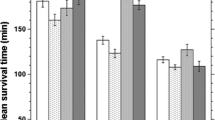Abstract
A cold stress applied to young flies can have positive effects on longevity, behavioral aging, and resistance to heat and infection. However, the same mild stress, if applied at older ages, i.e. in frailer flies, could be a strong stress with negative effects. Cold stress was applied at various ages (weeks 1–2, 2–3, 3–4, and 4–5) and its effect on longevity and on resistance at 6 weeks of age to heat or fungal infection was observed. In males, the cold stress had positive effects on longevity and resistance to infection, except when applied at the oldest age. No positive effect on longevity or resistance to infection was detected in cold-stressed females, as already observed in previous experiments using a cold stress at young age only. By contrast, cold stress applied at various ages increased resistance to heat in both sexes. Therefore, a mild stress can have positive effects on longevity and resistance to strong stresses not only when used at a young age, but also at older ages.




Similar content being viewed by others
References
Abete P, Rengo F (2008) Mild stress in the aging heart. In: Le Bourg E, Rattan SIS (eds) Mild stress and healthy aging. Applying hormesis in aging research and therapy. Springer, Dordrecht, pp 139–155
Burger JMS, Promislow DEL (2004) Sex-specific effects of interventions that extend life span. Sci Aging Knowl Environ 2004(28):30
Goodrick CL (1980) Effects of long-term voluntary wheel exercise on male and female Wistar rats. Gerontology 26:22–33
Goodrick CL, Ingram DK, Reynolds MA, Freeman JR, Cider NL (1980) Differential effects of intermittent feeding and voluntary exercise on body weight and lifespan in adult rats. J Gerontol 38:36–45
Harper JM, Leathers CW, Austad SN (2006) Does caloric restriction extend life in wild mice? Aging Cell 5:441–449
Hoffmann GR (2009) A perspective on the scientific, philosophical, and policy dimensions of hormesis. Dose Response 7:1–51
Ji LL (2008) Physical activity: a strong stimulant for hormesis during aging. In: Le Bourg E, Rattan SIS (eds) Mild stress and healthy aging. Applying hormesis in aging research and therapy. Springer, Dordrecht, pp 97–114
Kahn A, Olsen A (2010) Stress to the rescue: is hormesis a ‘cure’ for aging? Dose Response 8:48–52
Le Bourg E (2007) Hormetic effects of repeated exposures to cold at young age on longevity, aging and resistance to heat or cold shocks in Drosophila melanogaster. Biogerontology 8:431–444
Le Bourg E (2008) Three mild stresses known to increase longevity in Drosophila melanogaster flies do not increase resistance to oxidative stress. Am J Pharmacol Toxicol 3:134–140
Le Bourg E (2009) Hormesis, aging and longevity. Biochim Biophys Acta 1790:1030–1039
Le Bourg E (2010) Combined effects of suppressing live yeast and of a cold pretreatment on longevity, aging and resistance to several stresses in Drosophila melanogaster. Biogerontology 11:245–254
Le Bourg E, Rattan SIS (eds) (2008) Mild stress and healthy aging. Applying hormesis in aging research and therapy. Springer, Dordrecht
Le Bourg E, Rattan SIS (2010) “Is hormesis applicable as a pro-healthy aging intervention in mammals and human beings, and how?” Introduction to a special issue of Dose-Response. Dose Response 8:1–3
Le Bourg E, Massou I, Gobert V (2009) Cold stress increases resistance to fungal infection throughout life in Drosophila melanogaster. Biogerontology 10:613–625
Le Rohellec M, Le Bourg E (2009) Contrasted effects of suppressing live yeast from food on longevity, aging and resistance to several stresses in Drosophila melanogaster. Exp Gerontol 44:695–707
Mattson MP, Calabrese EJ (eds) (2010) Hormesis. A revolution in biology, toxicology and medicine. Springer, New York
Olsen A, Vantipalli MC, Lithgow GJ (2006) Lifespan extension of Caenorhabditis elegans following repeated mild hormetic heat treatments. Biogerontology 7:221–230
Pardon MC (2010) Hormesis is applicable as a pro-healthy aging intervention in mammals and human beings. Dose Response 8:22–27
Rattan SIS (2008) Hormesis in aging. Ageing Res Rev 7:63–78
Samorajski T, Delaney C, Durham L (1985) Effect of exercise on longevity, body weight, locomotor performance, and passive-avoidance memory of C57BL/6J mice. Neurobiol Aging 6:17–24
Sørensen JG, Kristensen TN, Kristensen KV, Loeschcke V (2007) Sex specific effects of heat induced hormesis in Hsf-deficient Drosophila melanogaster. Exp Gerontol 42:1123–1129
Sørensen JG, Sarup P, Kristensen TN, Loeschcke V (2008) Temperature-induced hormesis in Drosophila. In: Le Bourg E, Rattan SIS (eds) Mild stress and healthy aging. Applying hormesis in aging research and therapy. Springer, Dordrecht, pp 65–79
Talan MI, Ingram DK (1986) Effects of voluntary and forced exercise on thermoregulation and survival in aged C57BL/6J mice. Mech Ageing Dev 36:269–279
Terzibasi E, Lefrançois C, Domenici P, Hartmann N, Graf M, Cellerino A (2009) Effects of dietary restriction on mortality and age-related phenotypes in the short-lived fish Nothobranchius furzeri. Aging Cell 8:88–99
Vaiserman AM (2010) Hormesis, adaptive epigenetic reorganization, and implications for human health and longevity. Dose Response 8:16–21
Yashin AI, Cypser JW, Johnson TE, Michalski AI, Boyko SI, Novoseltsev VN (2002) Heat shock changes the heterogeneity distribution in populations of Caenorhabditis elegans: does it tell us anything about the biological mechanism of stress response? J Gerontol Biol Sci 57A:B83–B92
Acknowledgment
Many thanks are due to Isabelle Massou for her help in rearing the fungus B. bassiana.
Author information
Authors and Affiliations
Corresponding author
Rights and permissions
About this article
Cite this article
Le Bourg, É. A cold stress applied at various ages can increase resistance to heat and fungal infection in aged Drosophila melanogaster flies. Biogerontology 12, 185–193 (2011). https://doi.org/10.1007/s10522-010-9309-0
Received:
Accepted:
Published:
Issue Date:
DOI: https://doi.org/10.1007/s10522-010-9309-0




